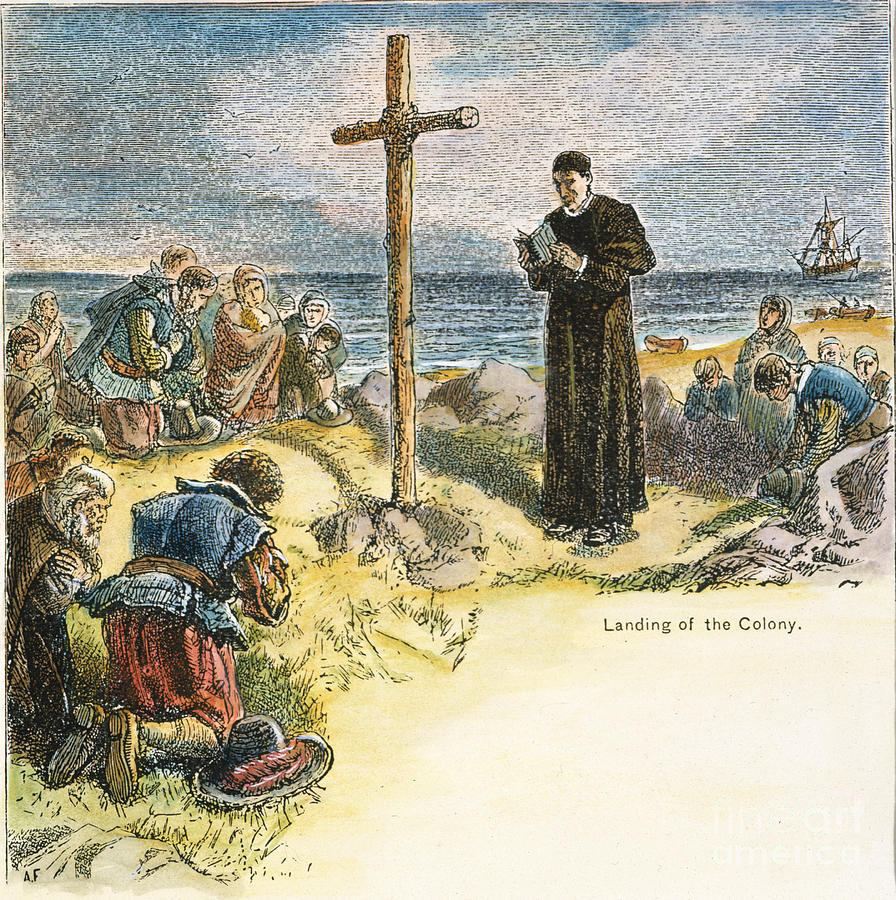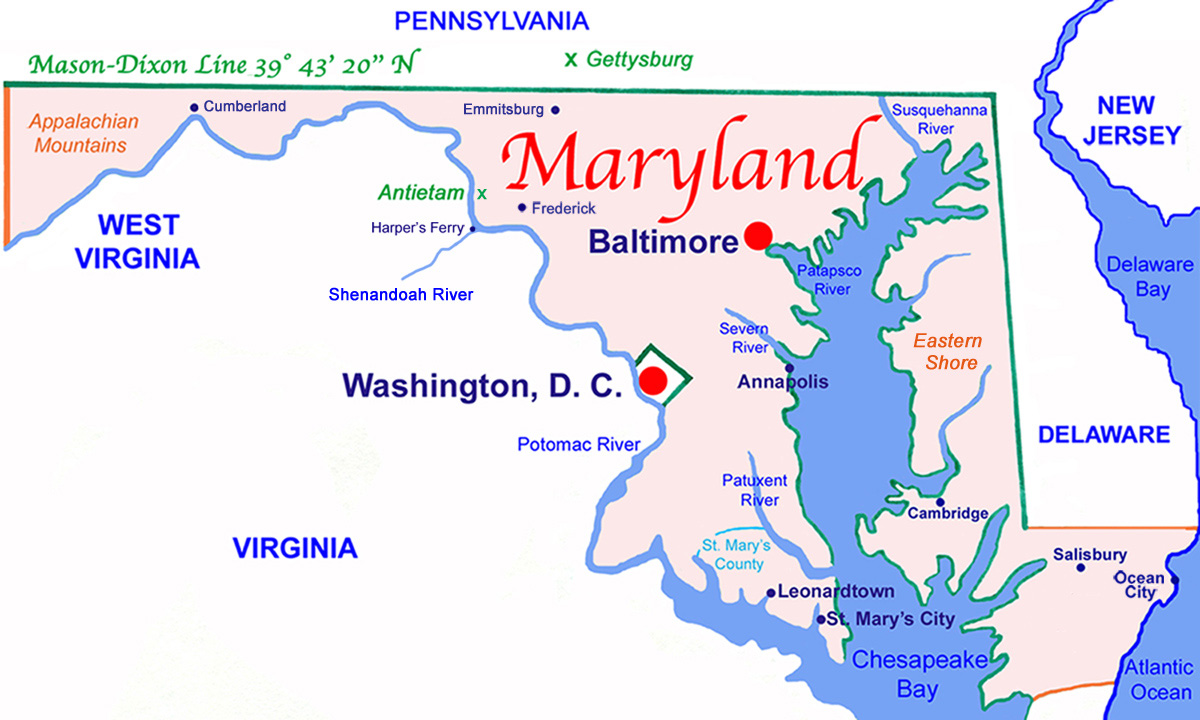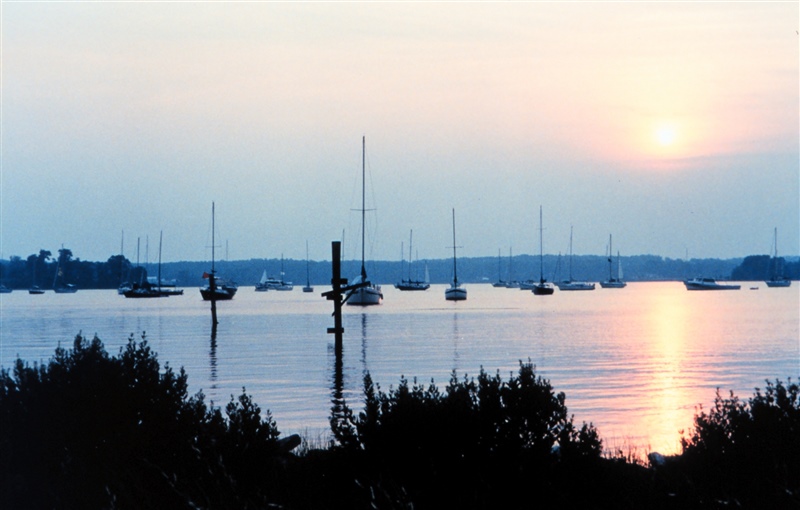
Maryland was one of four of the original 13 English colonies that was specifically chartered for religious freedom, as a refuge from religious persecution. Maryland was the primary entry point for Catholics in the English colonies. Lord Baltimore George Calvert was secretary of state for King James I and converted to Catholicism in 1625. He resigned upon succession by the son Charles I rather than swear allegiance to the Anglican Church of England. However, Charles I repaid the Calverts for loyal service, and granted Lord Baltimore a proprietary charter for Catholics. When the first Lord Baltimore George Calvert died on April 15, 1632, the Charter was granted to his son Cecil Calvert, the Second Lord Baltimore, on June 20, 1632 to land from the south bank of the Potomac River north to the 40th Parallel. The Calverts wanted a refuge for Catholics but also believed in religious toleration for all Christians. King Charles, in the Charter written in Latin, titled the colony Terra Mariae, or Land of Mary, but did not specify for whom the colony was named. 1-3
With Catholics and Protestants aboard, Leonard Calvert, Cecil’s younger brother, sailed 123 days on the Ark and the Dove and crossed the Atlantic; after sailing through the Chesapeake Bay and into the Potomac River, they landed on St. Clement’s island on March 25, 1634, the feast of the Annunciation. They put up a cross there in honor of our Saviour Jesus Christ. The same day the Catholics gathered on shore for a Mass celebrated by one of the three Jesuit priests aboard, Father Andrew White SJ, who dedicated Maryland to Mary, the Mother of God. This was the first Roman Catholic Mass in the thirteen English-speaking colonies. To this day March 25 is celebrated as Maryland Day by the State of Maryland. 1-5
The seafarers then headed 17 miles downstream on the Potomac River and traveled up an inlet, which they named St. Mary’s River, and landed at a village of the Yaocomico, a branch of the Piscataway Indians. Leonard Calvert purchased the village and adjacent land from the Indians on March 27, 1634, and this became St. Mary’s City. St. Mary’s County was founded in 1637. The settlers named the City, the County, and the Territory in honor of the Blessed Virgin Mary, a tradition that has been preserved among Maryland Catholics. It certainly helped that the beloved wife of Charles I was the devout Catholic Henrietta Maria. Leonard Calvert was the first governor of the Maryland Colony and lived in St. Mary’s City, the County Seat. The Catholic Chapel in St. Mary’s City was originally built in 1667. St. Mary’s City became the first capital of Maryland and remained so until 1695. 1-7

The seventeenth century was a time of religious wars throughout Europe. England was no exception, which accounted for the various sects seeking religious freedom in the American colonies. The colonial history of Maryland was intertwined with events in England. King Charles I (1625-1649) was the second Stuart King, and followed his father King James I (who commissioned the King James Bible of 1611). King Charles married Henrietta Maria, the Catholic Princess of France in 1625. The Princess was named after her father Henry IV of France and signed her letters Henrietta while living in France. Protestant England was distressed with the Royal Family, because of the King’s benevolence to Catholics, and because Henrietta took the royal children and her courtiers to Mass at her private chapel, and maintained her Catholic ties with the Pope and France. The struggle between the Monarchy and Parliament came to a head with King Charles I. King Charles was beheaded January 30, 1649. The Carolina states were named after King Charles I (Carolus in Latin), and Cape Henrietta Maria, at the juncture of the Hudson and James Bays in Northern Ontario, Canada, was named after the Queen. 8-9
Leonard Calvert and the Catholics had a difficult time in Maryland from the very beginning, as religious tension in England spilled over to the American colonies. Maryland Catholics gradually became outnumbered and conflict increased between Catholics and Protestants, especially after the Puritans, at the invitation of the Calverts, settled in Providence (now Annapolis) in 1648. To prevent strife, Lord Baltimore Cecil Calvert and the Maryland General Assembly formalized his original intent and passed the historic Toleration Act on April 21, 1649, a law to provide religious harmony among Christians. An Act Concerning Religion, which became known as The Toleration Act of Maryland, proved to be a compromise between Catholics and Protestants for toleration of Trinitarian Christian religions. 1-4, 10-11
Both Catholics and the Toleration Act of Maryland continued to suffer a rocky road throughout the colonial history of Maryland, especially after the Glorious Revolution of England in 1688, when the Catholic King James II was deposed by his Protestant daughter Mary and her husband William of Orange. The control of Maryland colony was then transferred from the Catholic proprietor to the Crown, which enabled the Protestant majority in the Maryland Assembly to repeal the Toleration Act of Maryland in 1692. Subsequently, Catholics in Maryland were not allowed to hold public office or practice law, and not even allowed to celebrate Mass in public or provide religious education for their children! Jesuit missionaries in particular, who had converted both Indians and Protestants alike, suffered persecution. The Capital of Maryland was moved in 1695 from St. Mary’s City to Annapolis, which was more central to the state and had grown wealthy through the slave trade. The Anglican Church of England was established as the state Church in 1702, and Catholics were taxed for its support. In 1704, by order of the royal governor, the sheriff of St. Mary’s County locked the doors of St. Mary’s Chapel, which was later dismantled, brick by brick. And this was in the first colony that had been founded on the principle of religious toleration! The death of the Catholic Charles Calvert, the third Lord Baltimore (1675-1715), brought the Anglican Benedict Calvert (who died within two months) and his son the Anglican Charles Calvert II, the fifth Lord Baltimore, who served 1715-1751. Catholics subsequently lost the right to vote in 1718. 7, 11-14
However, Catholics maintained a presence through it all. The Irish Catholic Charles Carroll the Settler migrated to Maryland in 1688 and was appointed the Attorney General of Maryland. Frustrated in politics because of his faith, he turned his energy to procurement of Maryland property and became a wealthy planter. Three grandsons of Charles Carroll the Settler made important contributions to the formation of our young Nation. Several Catholic families seeking religious freedom left St. Mary’s County and traveled northwest in 1728 to what is now Emmitsburg in Frederick County, Maryland. They named the mountain there St. Mary’s and the valley St. Joseph’s Valley. 12-14

Marylanders became united because of British oppression after the Seven Years War (1756-1763), beginning with the Stamp and Quartering Acts of 1765. The death of Frederick Calvert, the sixth and last Lord Baltimore (1751-1771), left Maryland Colony without British proprietary leadership. Charles Carroll of Carrollton received his chance to enter Maryland politics in a debate with the Loyalist Daniel Dulany in the Maryland Gazette in the first half of 1773 over an arbitrary fee schedule imposed upon Maryland on November 26, 1770 by the last British Governor Robert Eden (1769-1776). In four letters published under the pseudonym of First Citizen, Carroll eloquently defended Liberty and the natural rights of man, opposed taxation without representation, and asserted the nature of government was instituted for the general good. It was not lost on Marylanders that a Catholic was defending Protestants and Catholics alike. The Popular Party subsequently swept elections in May of 1773. In response to requests from Massachusetts and Virginia, the October 1773 session of the newly-elected colonial assembly established a Committee of Correspondence to coordinate efforts in safeguarding American interests, and then passed a tobacco inspection act without the offensive fee schedule. 12-15
The last colonial assembly met on April 19, 1774 and was prorogued (dissolved) by Governor Eden. Patriotic Marylanders then established a Provincial Government and held their first Annapolis Convention June 22-25, 1774. Charles Carroll was elected a representative from Anne Arundel County to the Convention, the first time a Catholic was elected to public office in 82 years. The 1774 Convention elected Matthew Tilghman as President and supported the American non-importation agreement and elected representatives to the First Continental Congress. The Annapolis Convention formed a Council of Safety in July 1775 with Daniel of St. Thomas Jenifer as Chairman, to organize the defense of Maryland. Joining Samuel Chase, William Paca, and Thomas Stone in July of 1776 as elected representatives of Maryland to Philadelphia, Charles Carroll of Carrollton became the only Catholic signer of the U. S. Declaration of Independence.12-15
The Maryland regulars performed bravely during the Revolutionary War. Their finest hour occurred at Brooklyn on Long Island, New York, when George Washington and the Continental Army were overwhelmed by the British. Washington knew he had to retreat and escape with his army to Manhattan on August 29, 1776. It was felt the hand of Providence aided their effort. Five British warships were unable to sail upriver and block the Army’s escape because of a shift in winds. A daring overnight escape over the East River was not enough to evacuate all the troops, but a thick morning fog rolled in and covered the boats. 250 Marylanders attacked General Cornwallis and the British redcoats to cover the retreat, risking capture or death. George Washington exclaimed, “Good God, what brave fellows I must lose this day.” He named the Maryland troops The Old Line, the name by which our state is still known – The Old Line State. 16
The Ninth Annapolis Convention adopted a Constitution in November 1776 which allowed freedom of religion for all Christians. Thomas Johnson was elected the first Governor of Maryland and began serving on March 21, 1777. Daniel Carroll II of Rock Creek signed the Articles of Confederation for Maryland on March 1, 1781, and also attended the Constitutional Convention in Philadelphia and was a signer of the Constitution of the United States on September 17, 1787. Maryland became the seventh State of the Union when it ratified the U. S. Constitution on April 28, 1788. Thomas Johnson, Daniel Carroll of Maryland, and David Stuart of Virginia were appointed by George Washington in 1791 as the three Commissioners for the new District of Columbia. Daniel Carroll donated a farm as the site for the building of the Capitol Building in Washington.
And John Carroll, Daniel’s brother, became the first American Bishop of the Catholic Diocese of Baltimore in 1789, a diocese which included the entire United States. Bishop Carroll founded Georgetown College in 1789. In 1806, he laid the cornerstone for the first American Cathedral, the Basilica of the Assumption of the Blessed Virgin Mary in Baltimore. During his tenure as Archbishop, Elizabeth Ann Seton opened the first Catholic elementary school in the United States in Baltimore, and Father John Dubois founded Mount St. Mary’s College and Seminary in Emmitsburg, Maryland, both in 1808. Elizabeth Ann Seton, the first American Saint, also founded the Sisters of Charity at St. Joseph’s Valley in Emmitsburg in 1809. 17-18
During the War of 1812 against Britain, the British attacked Washington, and burned the Executive Mansion, the Capitol Building, and the Library of Congress. They then sailed back up the Chesapeake Bay to Baltimore and attacked Fort McHenry on September 13, 1814. Following the 25-hour British bombardment of Fort McHenry, Francis Scott Key was so moved to see the American Flag still flying at dawn of September 14 that he wrote The Star-Spangled Banner. 19
The Star-Spangled Banner
Oh, say, can you see, by the dawn’s early light,
What so proudly we hailed at the twilight’s last gleaming?
Whose broad stripes and bright stars, thru the perilous fight,
O’er the ramparts we watched, were so gallantly streaming?
And the rockets’ red glare, the bombs bursting in air,
Gave proof through the night that our flag was still there.
O say, does that star-spangled banner yet wave
O’er the land of the free and the home of the brave?
On the shore dimly seen through the mists of the deep,
Where the foe’s haughty host in dread silence reposes,
What is that which the breeze, o’er the towering steep,
As it fitfully blows, half conceals, half discloses?
Now it catches the gleam of the morning’s first beam,
In full glory reflected, now shines on the stream:
Tis the star-spangled banner: O, long may it wave
O’er the land of the free and the home of the brave!
And where is that band who so vauntingly swore
That the havoc of war and the battle’s confusion
A home and a country should leave us no more?
Their blood has washed out their foul footsteps’ pollution.
No refuge could save the hireling and slave
From the terror of flight or the gloom of the grave:
And the star-spangled banner in triumph doth wave
O’er the land of the free and the home of the brave.
O, thus be it ever when freemen shall stand,
Between their loved home and the war’s desolation!
Blest with victory and peace, may the heav’n-rescued land
Praise the Power that hath made and preserved us a nation!
Then conquer we must, when our cause. it is just,
And this be our motto: “In God is our trust.”
And the star-spangled banner in triumph shall wave
O’er the land of the free and the home of the brave!
September 14, 1814

Maryland has flourished through the years. The Toleration Act of Maryland is significant as the first law towards the establishment of religious freedom in the history of our nation, and historians consider the Act the historical prelude to the First Amendment of the Constitution of the United States. In fact, the guarantee of religious freedom in the first Amendment of the U. S. Bill of Rights uses the same phrase as the Act: free exercise thereof. And The Star-Spangled Banner written in Baltimore served as the military anthem until it was officially signed into law as the National Anthem of the United States of America on March 3, 1931. 20

1 Morison SE. Oxford History of the American People. Oxford University Press, New York, p 80, 1965. Samuel Eliot Morison, Professor of History at Harvard, wrote: “The province was named Maryland ostensibly after Queen Henrietta Maria but really in honor of the Virgin Mary.”
2 Bennett, William J. America – The Last Best Hope. Thomas Nelson, Nashville, Volume l, page 43, 87-88, 2006.
3 Alvarez R. First and Forever – The Archdiocese of Baltimore. Editions du Signe, Strasbourg, France, 2006.
4 Personal Communication, St. Mary’s County Government, St. Mary’s County, Maryland, 2009.
5 Mother of Light Shrine, St. Clement’s Island Museum, Colton’s Point, St. Mary’s County, Maryland. The inscription on one face of the marker begins: Maryland was dedicated to Mary, the Mother of God, during the first Mass held on St. Clement’s Island.
6 Treacy WP. Old Catholic Maryland and Early Jesuit Missionaries. Bibliolife, Charleston, South Carolina, 1889, 2009.
7 Zimmermann M. “St. Mary’s Chapel, Maryland.” The Catholic Standard, Archdiocese of Washington, D. C., 7, July 19, 2012.
8 Morrill J (ed). Oxford History of Tudor and Stuart Britain. Oxford University Press, New York, 1996.
9 Spielvogel JJ. Western Civilization, Sixth Combined Edition, Thomson Wadsworth, Belmont, California, 2006.
10 The Toleration Act of Maryland, Courtesy of the Maryland State Archives, Maryland.
11 Marck JT. Maryland The Seventh State, A History. Fourth Edition, Creative Impressions, Glen Arm, Maryland, 1998.
12 Hanley TO. Charles Carroll of Carrollton: The Making of a Revolutionary Gentleman. Catholic University of America Press, Washington, DC, 1970.
13 Onuf PS. Maryland and the Empire, 1773: The Antilon – First Citizen Letters. Johns Hopkins University Press, Baltimore, Maryland, 1974.
14 McDermott S. Charles Carroll of Carrollton. Scepter Press, New York, 2002.
15 Hoffman R. A Spirit of Dissension. Johns Hopkins University Press, Baltimore, Maryland, 1973.
16 McCullough D. 1776 – The Illustrated Edition. Simon & Schuster, New York, page 161 and following, 2007.
17 Lomask M. John Carroll, Bishop and Patriot. (New York: Farrar Straus and Cudahy, 1956), 175-181.
18 Walters J. Elizabeth Ann Seton: Saint for a New Nation. Paulist Press, Mahwah, New Jersey, 2002.
19 Ravitch D, Editor. The American Reader. Harper, New York, 44-46, 1991.
20 Noonan JT. The Lustre of Our Country, The American Experience of Religious Freedom. University of California Press, Berkeley, 2-4, 90-91, 1998.



